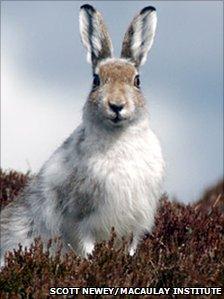Heavy snow hampered Scottish blue hare count
- Published

Mountain hares change colour in winter to camouflage them
Heavy snowfalls in 2010 hampered efforts to monitor numbers of mountain hare in upland areas of Scotland, according to a new report.
Also known as blue hare, they are Britain's only native hare and may have been here since the Ice Age.
The report, published by Scottish Natural Heritage, was commissioned in a bid to develop a reliable method for estimating hare numbers.
It said snow may also have driven hares from their usual territories.
According to SNH, heather moorland managed for grouse shooting provides the best habitat for mountain hare.
On prime habitat in the eastern Highlands, the agency estimates there could be up to 200 animals per sq km.
Research in 2008 involving SNH estimated that the UK has about 350,000 mountain hares.
The hares change colour in winter, turning white to camouflage them against the snow.
They are also known as blue hares because one of their summer colours is a bluish grey.
Brown hare, which can be seen on farmland across Scotland, were introduced to Britain possibly by the Romans or during the Iron Age.
'Difficult to catch'
Current methods of estimating numbers involve trapping, and then releasing, hares and also surveying deposits of their dung.
However, the report's authors said snowy conditions in 2010 had an impact on matching up the trapping and dung count figures to give an accurate estimate.
The report said: "Mountain hares are difficult to catch and capture rates are dependant on population density and strongly influenced by weather.
"Both phase one and phase two trapping programmes were carried out during unseasonably and exceptional snowy and inclement weather which, as well as making logistics very difficult and meant that some trapping had to be cancelled, appears to have resulted in incredibly low trapping success."
'Current interest'
Researchers speculated that hares may have moved from home ranges to more sheltered areas because of heavy snow.
Among their findings, they said: "With current interest and discussion over the management and conservation of mountain hares there is a clear need to develop reliable, robust and easily-implemented survey methods."
The Macaulay Land Use Research Institute and Game and Wildlife Conservation Trust were involved in putting together the report.